5 Central Governor and Fatigue
Definition, purpose, and Brief History of the central governor model
The Central Governor Model (CGM) is a recently proposed general model for explaining the phenomenon of fatigue. This model suggests that the subconscious brain regulates power output by controlling motor unit recruitment to maintain whole-body homeostasis and avoid catastrophic physiological failure, such as rigor. The subconscious brain determines the metabolic cost required to perform the exercise task, based on environmental conditions and the physical state of the organism, and selects a pacing strategy that ensures completion of the exercise without presenting a major threat to internal homeostasis, which would result in a “terminal metabolic crisis.“ This emphasizes the importance of homeostasis in all organ systems during exercise to maintain overall health and prevent exhaustion. In this model, the word ‘fatigue’ is used as a sensation or emotion, rather than just a decline in the ability to produce force and power during exercise.
The central governor model was first proposed by Tim Noakes, a South African sports scientist, in 1997. He suggested that fatigue during exercise is not caused by the depletion of energy stores or the accumulation of waste products, but rather by the brain’s perception of the physiological strain of exercise. Noakes suggested that the brain continuously monitors the body’s physiological status during exercise and regulates the power output of the muscles to prevent injury or damage.
The purpose of the central governor model is to provide an explanation for how the body regulates exercise intensity to prevent overexertion and injury. It is based on the idea that the body has a “safety mechanism” that limits the intensity of exercise to prevent catastrophic failure.
Since proposed, the central governor model has been widely studied and debated within the scientific community. While some researchers have provided evidence to support the model, others have challenged its validity and proposed alternative theories to explain the regulation of exercise intensity. Nonetheless, the central governor model remains an important framework for understanding how the body regulates exercise intensity and the limits of human physical performance.
Explanation of muscle fatigue during exercise and previous theories on fatigue
The musculoskeletal system is a crucial component of the body and comprises muscles, tendons, cartilage, ligaments, connective tissues, and nerves. Muscle tissue makes up about 40% of the whole-body weight, and it plays a vital role in maintaining posture and balance, facilitating physical tasks, aiding in respiratory mechanics, and protecting internal organs. Muscles also store minerals, fat, and carbohydrates in the form of glycogen and help with the movement of substances and body heat generation. Additionally, they assist in returning venous blood from the lower limbs to the right side of the heart.
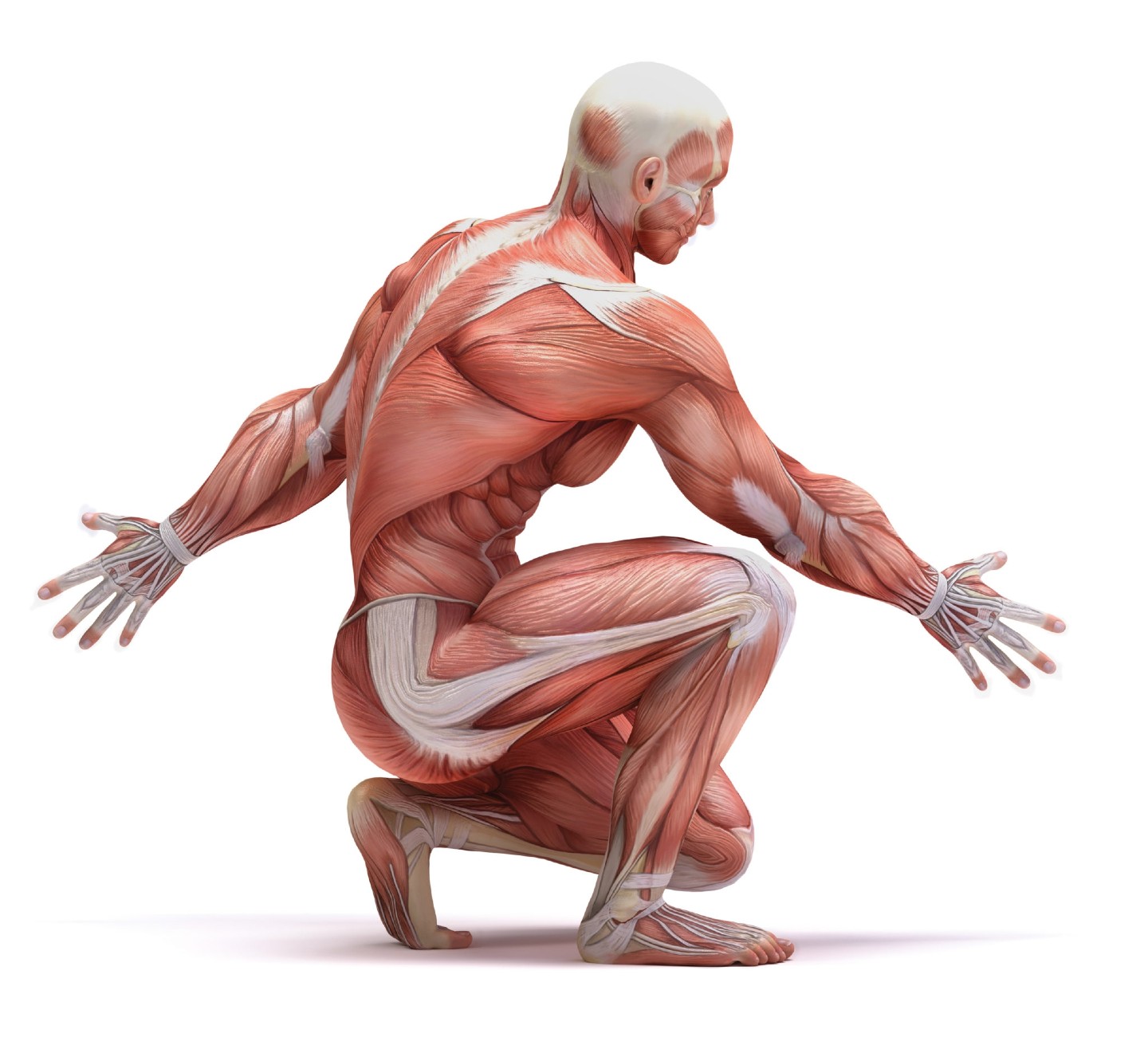
Hkingcbs. “Teaching the Muscular System.” Carolina Knowledge Center, 11 Aug. 2022, https://knowledge.carolina.com/discipline/life-science/anatomy-and-physiology/muscular-system/.
There are three main types of muscle tissue: skeletal, cardiac, and smooth. Skeletal muscles are fibrous tissues attached to bones by tendons, and they contract upon neuro-mediated calcium stimulation, allowing for body movement while maintaining the position of body parts.
The term “muscle fatigue” refers to a reduction in the ability of muscles to generate maximum force or power following contractile activity. It can stem from different points along the motor pathway and is typically classified as either peripheral or central fatigue. Peripheral fatigue occurs due to alterations that take place at or distal to the neuromuscular junction. Central fatigue arises from the central nervous system, which lowers the neural drive to the muscles. Muscle fatigue is a common occurrence that limits athletic performance and other strenuous or prolonged activities. It also restricts daily life under various pathological conditions, including neurological, muscular, and cardiovascular disorders, aging, and frailty.
Muscle fatigue can be classified as acute or chronic. Acute fatigue is due to strenuous physical activities and results from the accumulation of waste products in the intracellular space or depletion of energy-rich compounds. Recovery time depends on the intensity and duration of the task. The usual interventions to speed up recovery include massage, cold compression, and light analgesics. Chronic fatigue can be caused by muscle atrophy due to immobilization, chronic inflammation, trauma, critical illness, medication, aging, or neurogenic muscle atrophy due to obstructions or interference with different stages of nerve signal propagation.
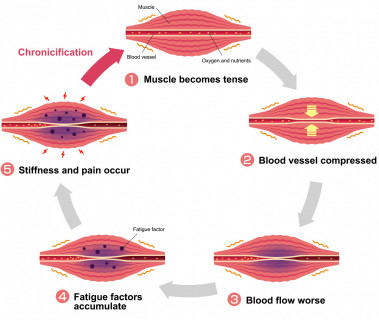
Pressure on soft-walled blood vessels caused by trigger points restricts blood flow to muscles.
This phenomenon of muscle fatigue and has been recognized by individuals for centuries, although investigations into its mechanisms are relatively recent. (Needham, 1971) provides a comprehensive historical account of muscle contraction and metabolism and cites (Berzelius, 1807) for the discovery that lactic acid is present in the muscles of exhausted animals. The experimental study of muscle fatigue was first introduced by (Mosso, 1904), who demonstrated the rapid onset of fatigue in humans when lifting a heavy load with a finger. Interestingly, even when the nerve was electrically stimulated, fatigue still occurred, suggesting that the cause is within the muscle rather than in the central nervous system. (Hill and Kupalov, 1929) made a significant contribution to the field by showing that an isolated frog muscle, stimulated in N2 (Nitrogen) gas, fatigued quickly and accumulated lactic acid.
Voluntary muscle contractions occur through a complex process that begins in the cortex and ends with the excitation of lower motor neurons in the spinal cord. The resulting action potentials are then carried by the axons of these neurons to the muscle’s neuromuscular junction. The entire process is generally categorized into two parts: central, which refers to the processes inside the spinal cord and above, and peripheral, which refers to the processes in the peripheral nerve, neuromuscular junction, and muscle. Fatigue can occur at various points along this pathway and is divided into central and peripheral fatigue. Early studies conducted by (Merton, 1954) demonstrated that fatigue in a small hand muscle could be entirely peripheral in well-motivated individuals. However, later studies suggest that during maximal activation of muscles, a small degree of central failure of activation occurs, and there is often a substantial central component during fatigue.
Although muscle fatigue and muscle injury overlap, it is usual to make a distinction between them. Fatigue is usually defined as the reversible decline of performance during activity, and most recovery occurs within the first hour. However, there is also a slowly reversible component that can take several days to reverse. Muscle injury also causes a decline in performance that reverses only very slowly. Muscles that are stretched during contraction (eccentric contractions)are particularly prone to injury or damage. Injury is characterized by structural abnormalities including sarcomeric disorder, membrane damage resulting in the loss of soluble enzymes such as creatine kinase, and inflammatory processes including cytokine release and phagocytic cell infiltration. Recovery from the most serious injuries involves activation of satellite cells and regeneration of damaged fibers.
The Central Governor Model (Homeostasis)
Brain as the central governor of fatigue
Perception of effort and regulation of exercise intensity
Role of the brain in monitoring physiological state
Factors affecting fatigue, such as energy availability, muscle fatigue, and perceived effort

The Central Governor model. Replicated from Marcora, 2008
Being able to control one’s thoughts, emotions, or behaviors to override an automatic response is important for a range of behaviors that affect mental health, physical health, academic success, and relationship quality. The strength model (SM) is a well-known theory of self-regulation that suggests all self-regulatory efforts use a common and limited energy source. Self-regulatory effort can lead to temporary self-regulatory fatigue or, which can cause regulatory failure. The SM has strong empirical support, but it has some weaknesses, such as not accounting for recent findings that people can self-regulate after being “depleted” and not adequately explaining the role of motivation in self-regulation. Current knowledge about the causes and moderators of physical fatigue provides an instructive parallel for understanding the nature and causes of self-regulatory fatigue. Physical fatigue and self-regulatory fatigue behave as if resources were limited, despite the fact that they may not be. Inputs that determine the experience of physical fatigue include both motivational states and physiological resources, which informs an understanding of self-regulatory fatigue that is consistent with empirical findings and generates new directions for research in self-regulatory fatigue.
The glucose depletion hypothesis suggests that self-regulatory failure is caused by a lack of glucose, which is an acceptable idea given that self-regulatory fatigue feels like a depletion of something. Physiologically speaking, self-regulation is associated with changes in the parasympathetic nervous system activity that are normally associated with resource conservation, and self-regulatory tasks correlate with energetically conservative changes in various bodily systems. However, recent research has shown significant weaknesses in this hypothesis, including the lack of evidence that self-regulatory tasks decrease glucose relative to baseline, the negligible amount of total brain energy expended on any one cognitive task, and the inconsistency between the rate of absorption of glucose and empirical findings. These weaknesses suggest that glucose may instead provide a signal value regarding the expected availability of energy. Furthermore, the glucose depletion hypothesis fails to account for the findings that performance on some complex mental tasks improves after vigorous physical exercise, which is associated with decreases in levels of blood glucose.
Furthermore, studies using animal models have suggested that reductions in brain glucose can occur during complex cognitive tasks. However, these findings may not necessarily apply to self-regulatory fatigue in humans. For example, a study found that during a cognitively demanding maze task, extracellular glucose levels in the hippocampus of rats decreased by 31%, whereas during a less demanding maze task, the decrease was only 11%. Additionally, glucose administration prior to the maze task only improved performance on the more complex maze (McNay et al., 2000).
Moreover, findings that suggest changes in participants’ perceptions of task difficulty can alter levels of self-regulatory fatigue are difficult to reconcile with the SM or the glucose depletion hypothesis. For example, participants who were made to believe they were more fatigued exhibited reduced persistence on a subsequent self-regulatory task compared to those who were made to believe they were less fatigued (Clarkson et al., 2010). Similarly, when participants’ implicit theories of self-regulation were manipulated by having them believe that self-regulation was either a limited or non-limited resource, those who believed it was limited showed impaired performance on a subsequent task (Job et al., 2010). Interestingly, challenging participants’ expectancies about self-regulation being a limited resource improved performance, which suggests that the nature of the task is less important than participants’ beliefs about their ability to perform it (Martijn et al., 2002)

“Neuromuscular System.” Healthdirect, Healthdirect Australia, https://www.healthdirect.gov.au/neuromuscular-system.
The current understanding of self-regulatory fatigue lacks an explanation for why these motivational shifts occur, which presents a major limitation to existing psychological and motivational explanations. These theories fail to provide a sufficient explanation for why it would be adaptive to experience self-regulatory fatigue, given its importance in various aspects of life. Opportunity cost models attempt to address this question by suggesting that fatigue motivates individuals to switch to the next best available alternative in their environment. However, these models have significant flaws, such as their inability to account for why one particular activity would be chosen over another. Simply switching from one self-regulatory task to another with a better opportunity cost/benefit ratio would not necessarily solve the problem. Additionally, as research in the self-regulation literature suggests, switching between self-regulatory activities leads to performance declines on the second task.
Theories that suggest physical fatigue is due to a “catastrophic” failure of homeostasis, resulting from substrate depletion or toxin buildup, have been discussed throughout time, just as they have in the self-regulatory fatigue literature. However, similar to the self-regulatory fatigue literature, these theories have been challenged by the role of psychological factors. Muscle fatigue is traditionally defined as the inability to maintain a given level of muscle force output and is considered to reflect a catastrophic failure of homeostasis due to substrate depletion or toxin buildup. Nevertheless, various evidence suggests that these proposed mechanisms are unlikely to be directly responsible for muscle fatigue.
The exhaustion-induced termination of exercise does not appear to be caused by the depletion of energetic substrates such as glycogen, glucose, or adenosine triphosphate (ATP), which are the sources of muscle mechanical energy. Studies have shown that intramuscular levels of ATP never dropped below 50% of resting concentrations, and muscle glycogen stores are far from being completely depleted at exercise-induced exhaustion. This suggests that fatigue causes people to terminate exercise before their muscle energy reserves are fully spent. In addition to physiological factors, psychological influences such as hypnosis, sudden noises, music, and deception regarding workload can also affect effort and fatigue during exercise. These psychological factors suggest control by central mechanisms in addition to peripheral energy stores. The consumption of glucose can improve exercise performance, even when it is not ingested but merely swished in the mouth, suggesting that the detection of carbohydrates in the oral cavity alters the fatigue setpoint. Furthermore, studies have shown that imagining exercises without actual physical movement or muscle contraction can increase the strength of a muscle. This suggests that central nervous system factors play a significant role in determining the maximal force-generating capacity of skeletal muscles.
Evidence for the Central Governor Model
Scientific studies supporting the theory
Comparison with previous theories on fatigue
Explanation of the evidence and its implications
Noakes (1997) challenged the catastrophic failure model of muscle fatigue and proposed the existence of a central governor mechanism that limits further exertion to prevent homeostatic breakdown. This Central Governor Theory (CGT) suggests that the brain subconsciously regulates exercise performance by adjusting the number of active motor units based on a pacing strategy that ensures efficient completion of the task while maintaining metabolic and physiological reserves. The idea of central fatigue, which involves a progressive failure to voluntarily activate motor neurons and muscle fibers, had been previously established. Noakes (1997) was the first to integrate these concepts and propose a theory based on the principle of homeostasis preservation.
The Central Governor Model proposes that a central governor, possibly involving the anterior cingulate, determines feelings of fatigue based on feedback from multiple afferent signals such as metabolic rate, fuel reserves, and heat production rate. As homeostatic limits are approached, these feelings of fatigue increase, leading to a reduction in motor recruitment and ultimately terminating exercise. According to this theory, muscle fatigue is not defined by a physical reduction in muscle force output caused by peripheral factors like lack of energy, but rather a subjective feeling similar to an emotion that aims to protect the organism by maintaining homeostasis and guiding behavior. Therefore, muscle fatigue could be thought of as similar to physical pain, which is also a sensory experience that guides behavior to safeguard homeostasis and the body’s integrity. This idea matches with Thorndike’s concept that “Feelings of fatigue… serve as a sign to us to stop working long before our actual ability to work has suffered any important decrease” (Craig, 2003; Noakes et al., 2005; Gibson & Noakes, 2004).
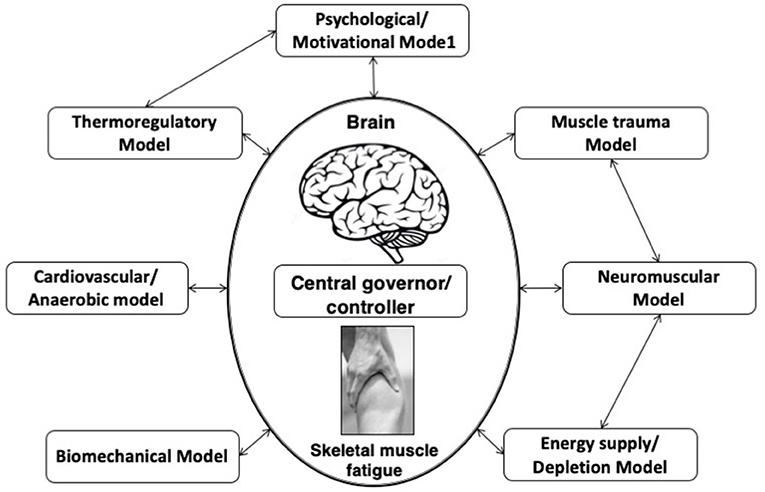
https://www.frontiersin.org/articles/10.3389/fnrgo.2022.841911/full.
The CGM proposes that fatigue is not just a physical event, but also an emotion (St Clair Gibson et al., 2003) that the brain uses to regulate exercise performance (Tucker, 2009). This is achieved by altering the rating of perceived exertion (RPE) which increases in a linear manner as the exercise bout progresses and reaches a maximum value at the end of a truly maximal physical effort (Noakes, 2004, 2008b; Tucker, 2009). As the RPE increases in a linear fashion with exercise duration, it must be predetermined either before the exercise bout or shortly after its commencement.
In order to distinguish the physical symptoms of exercise from the sense of effort involved in maintaining a work rate, (Swart et al., 2012) carried out a study, and subjects were instructed to use the Borg RPE scale to measure only the physical symptoms they experienced during exercise. To quantify their sense of effort, they were taught to use a new scale called the task effort and awareness (TEA) scale. During the study, the subjects completed two 100 km cycling bouts – one at maximal effort and the other at submaximal effort. The exercise bouts included a series of all-out 1 km sprints, and the subjects were instructed to perform these sprints with maximum effort.
The results of the study revealed that the RPE increased progressively during both exercise trials, and was lower in the submaximal trial. However, it only reached a maximum value of 19 in the final sprint of both trials. On the other hand, the TEA score was maximal at the end of each sprint, even during the submaximal trial in which each sprint began at a lower TEA and RPE score.
Therefore, the study suggests that the brain uses two distinct sets of fatigue symptoms to ensure that homeostasis is maintained during exercise. The first set is the physical sensations induced by exercise, which are captured by Borg’s original RPE scale. These physical sensations increase linearly with the duration of exercise and reach a maximum value only at the point of exercise termination. Maintaining an exercise intensity that produces this linear increase in RPE provides the optimal pacing strategy.
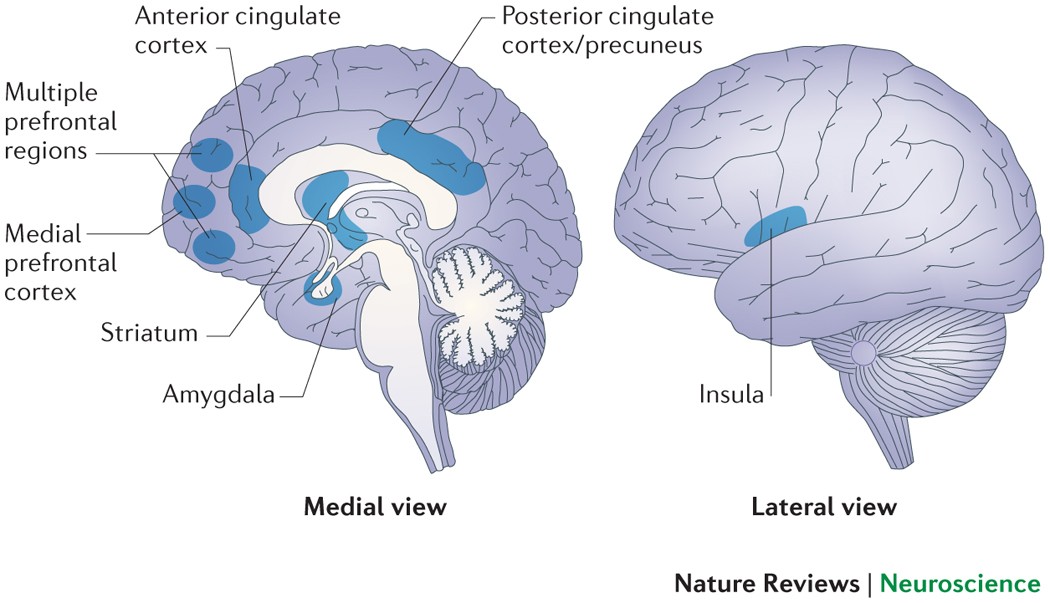
Tang, Yi-Yuan, et al. “The Neuroscience of Mindfulness Meditation.” Nature News, Nature Publishing Group, 18 Mar. 2015, https://www.nature.com/articles/nrn3916.
Early studies have also provided evidence for the activation of specific regions in the brain in response to an increased sense of effort during exercise. These regions include the insular cortex, anterior cingulate cortex (ACC) or medial prefrontal region, as well as thalamic regions (Williamson et al., 2006). According to Williamson and colleagues, different areas within the insular cortex respond to inputs from skeletal muscle afferents and “central command,” while the anterior cingulate gyrus may work in conjunction with portions of the insular cortex as a “central command network” to interpret an individual’s sense of effort and elicit appropriate autonomic adjustments to affect cardiovascular responses. Thalamic regions are believed to be involved in the regulation of blood pressure through baroreflex mechanisms. Recent studies have further expanded upon these ideas, highlighting the complex neural mechanisms involved in the perception of effort during exercise.
According to research, certain brain regions are activated in response to exercise. In a study using fMRIto examine brain responses to pedaling exercise, (Mehta et al., 2009) found activation of various areas including the medial primary sensory and motor cortices, premotor cortex, supplementary area, and anterior cerebellum. Another study by (Hilty et al., 2011) investigated brain areas involved in the decision to terminate exercise and found activation of the mid/anterior insular region prior to the termination of fatiguing isometric handgrip contractions. This area is known to be involved in evaluating homeostatic threats, which suggests that its activation during exercise may signal an urgent imbalance. Furthermore, (Hilty et al.,2011) found evidence for increased communication between the mid/anterior insular and the motor cortex during fatiguing exercise, which could act as a central regulator of motor output to the exercising limbs in accordance with the central governor mechanism.
Implications of the Central Governor Model & conclusion
Impact on exercise science and performance
Implications for athletic training and injury prevention
Potential for further research and application
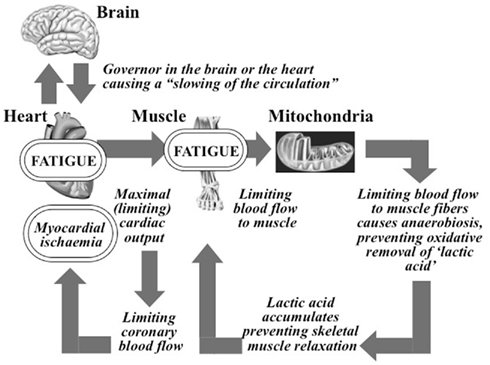
The Central Governor Model of Exercise Regulation … – Researchgate. https://www.researchgate.net/figure/The-Central-Governor-Model-of-Exercise-Regulation-proposes-that-the-brain-regulates_fig2_224709105.
One important difference between physical fatigue and self-regulatory fatigue is the ultimate function of the governing mechanism. Physical fatigue serves the purpose of maintaining homeostasis and protecting the organism from physical damage, but it is less clear what the purpose of self-regulatory fatigue is, or why we need a central governor in self-regulation. There are documented cases of physical damage resulting from overriding the central governor, such as tissue damage (Kim, Lee, & Kim, 2007; Neilan et al., 2006), but there is no evidence of neurological damage having ever occurred due to prolonged or intense bouts of self-regulation.
The SM and the glucose depletion hypothesis, motivation models, motivation/attention models, and opportunity cost models have all generated concrete and testable hypotheses. A model based on parallels with physical fatigue is broader than these theories in that it includes a number of motivational and physiological inputs as necessary for the experience of self-regulatory fatigue. Importantly, there are factors associated with physical fatigue that have not been tested with regard to self-regulatory fatigue. If self-regulatory fatigue and physical fatigue are close if not the same, then the same factors should affect both self-regulatory fatigue and physical fatigue.
The interdependence of performance fatigue and perceived fatigue, along with their determinants, suggests that they should not be considered in isolation. The factors primarily determining these types of fatigue in response to motor and cognitive tasks are not singular, but instead depend on the relative weight of each determinant and their interaction, which is influenced by factors such as body homeostasis, age, sex, diseases, and task characteristics. To fully comprehend the psychophysiology of motor and cognitive task-induced state fatigue, a combined assessment of performance fatigue and perceived fatigue measures, as well as their (neuro)physiological correlates, is necessary. By understanding the interactions between different dimensions of fatigue and their impact on human performance, effective interventions for increasing exercise tolerance and human performance in healthy and clinical populations can be designed.
By utilizing knowledge of physical fatigue, new hypotheses can be developed regarding the reasons, outcomes, and associations of self-regulatory fatigue and failure. A comprehensive approach that considers the relationship between physiological substrates and mental processes is necessary for researchers to fully comprehend self-regulatory fatigue. An integrated framework for both physical and self-regulatory fatigue has far-reaching implications for disciplines beyond psychology, such as exercise science, physical therapy, and medicine.
References
- Allen, D. G., Lamb, G. D., & Westerblad, H. (2008, Jan 1). Skeletal Muscle Fatigue: Cellular Mechanisms. https://journals.physiology.org/doi/full/10.1152/physrev.00015.2007
- Behrens, M., Gube, M., Chaabene, H. et al. Fatigue and Human Performance: An Updated Framework. Sports Med 53, 7–31 (2023). https://doi.org/10.1007/s40279-022-01748-2
- Clarkson, J. J., Hirt, E. R., Jia, L., & Alexander, M. B. (2010). When perception is more than reality: the effects of perceived versus actual resource depletion on self-regulatory behavior. Journal of personality and social psychology, 98(1), 29–46. https://doi.org/10.1037/a0017539
- Constantin-Teodosiu, D., & Constantin, D. (2021). Molecular Mechanisms of Muscle Fatigue. International Journal of Molecular Sciences, 22(21), 11587. MDPI AG. Retrieved from http://dx.doi.org/10.3390/ijms222111587
- Craig A. D. (2003). A new view of pain as a homeostatic emotion. Trends in neurosciences, 26(6), 303–307. https://doi.org/10.1016/s0166-2236(03)00123-1
- Evans, D. R., Boggero, I. A., & Segerstrom, S. C. (2016). The Nature of Self-Regulatory Fatigue and “Ego Depletion”: Lessons From Physical Fatigue. Personality and Social Psychology Review, 20(4), 291–310. https://doi.org/10.1177/1088868315597841
- Fatigue is a brain-derived emotion that regulates the exercise behavior to ensure the protection of whole body homeostasis – https://www.frontiersin.org/articles/10.3389/fphys.2012.00082/full
- Hagger, M. S., Wood, C., Stiff, C., & Chatzisarantis, N. L. (2010). Ego depletion and the strength model of self-control: a meta-analysis. Psychological bulletin, 136(4), 495–525. https://doi.org/10.1037/a0019486
- Hkingcbs. (2022, August 11). Teaching the muscular system. Carolina Knowledge Center. Retrieved from https://knowledge.carolina.com/discipline/life-science/anatomy-and-physiology/muscular-system/
- Inzlicht, M., & Marcora, S. M. (2016). The Central Governor Model of Exercise Regulation Teaches Us Precious Little about the Nature of Mental Fatigue and Self-Control Failure. Frontiers in psychology, 7, 656. https://doi.org/10.3389/fpsyg.2016.00656
- Jaberzadeh, Shapour, and Maryam Zoghi. “Transcranial Direct Current Stimulation Enhances Exercise Performance: A Mini Review of the Underlying Mechanisms.” Frontiers, Frontiers, 18 Mar. 2022, https://www.frontiersin.org/articles/10.3389/fnrgo.2022.841911/full.
- Job, V., Dweck, C. S., & Walton, G. M. (2010). Ego depletion–is it all in your head? implicit theories about willpower affect self-regulation. Psychological science, 21(11), 1686–1693. https://doi.org/10.1177/0956797610384745
- Kim, H. J., Lee, Y. H., & Kim, C. K. (2007). Biomarkers of muscle and cartilage damage and inflammation during a 200 km run. European journal of applied physiology, 99(4), 443–447. https://doi.org/10.1007/s00421-006-0362-y
- Martijn C., Tenbult P., Merckelbach H., Dreezens E., de Vries N. K. (2002). Getting a grip on ourselves: Challenging expectancies about loss of energy after self-control.
- McNay, E. C., Fries, T. M., & Gold, P. E. (2000). Decreases in rat extracellular hippocampal glucose concentration associated with cognitive demand during a spatial task. Proceedings of the National Academy of Sciences of the United States of America, 97(6), 2881–2885. https://doi.org/10.1073/pnas.050583697
- Neilan, T. G., Januzzi, J. L., Lee-Lewandrowski, E., Ton-Nu, T. T., Yoerger, D. M., Jassal, D. S., Lewandrowski, K. B., Siegel, A. J., Marshall, J. E., Douglas, P. S., Lawlor, D., Picard, M. H., & Wood, M. J. (2006). Myocardial injury and ventricular dysfunction related to training levels among nonelite participants in the Boston marathon. Circulation, 114(22), 2325–2333. https://doi.org/10.1161/CIRCULATIONAHA.106.647461
- “Neuromuscular System.” Healthdirect, Healthdirect Australia, https://www.healthdirect.gov.au/neuromuscular-system.
- Noakes, T. D., St Clair Gibson, A., & Lambert, E. V. (2005). From catastrophe to complexity: a novel model of integrative central neural regulation of effort and fatigue during exercise in humans: summary and conclusions. British journal of sports medicine, 39(2), 120–124. https://doi.org/10.1136/bjsm.2003.010330
- Noakes, T. D., & St Clair Gibson, A. (2004). Logical limitations to the “catastrophe” models of fatigue during exercise in humans. British journal of sports medicine, 38(5), 648–649. https://doi.org/10.1136/bjsm.2003.009761
- Noakes T. D. (1997). 1996 J.B. Wolffe Memorial Lecture. Challenging beliefs: ex Africa semper aliquid novi. Medicine and science in sports and exercise, 29(5), 571–590. https://doi.org/10.1097/00005768-199705000-00001
- Parasuraman, R., & Rizzo, M. (Eds.). (2007). Neuroergonomics: The brain at work. Oxford University Press.
- Swart, J., Lindsay, T. R., Lambert, M. I., Brown, J. C., & Noakes, T. D. (2012). Perceptual cues in the regulation of exercise performance – physical sensations of exercise and awareness of effort interact as separate cues. British journal of sports medicine, 46(1), 42–48. https://doi.org/10.1136/bjsports-2011-090337
- Tang, Yi-Yuan, et al. “The Neuroscience of Mindfulness Meditation.” Nature News, Nature Publishing Group, 18 Mar. 2015, https://www.nature.com/articles/nrn3916.
- The Central Governor Model of Exercise Regulation … – Researchgate. https://www.researchgate.net/figure/The-Central-Governor-Model-of-Exercise-Regulation-proposes-that-the-brain-regulates_fig2_224709105.
- Travers, G., Kippelen, P., Trangmar, S. J., & González-Alonso, J. (2022). Physiological Function during Exercise and Environmental Stress in Humans—An Integrative View of Body Systems and Homeostasis. Cells, 11(3), 383. MDPI AG. Retrieved from http://dx.doi.org/10.3390/cells11030383
- Trecroci, A., Boccolini, G., Duca, M., Formenti, D., & Alberti, G. (2020). Mental fatigue impairs physical activity, technical and decision-making performance during small-sided games. PloS one, 15(9), e0238461. https://doi.org/10.1371/journal.pone.0238461
- Wan, J. J., Qin, Z., Wang, P. Y., Sun, Y., & Liu, X. (2017). Muscle fatigue: general understanding and treatment. Experimental & molecular medicine, 49(10), e384. https://doi.org/10.1038/emm.2017.194
- Weir, J. P., Beck, T. W., Cramer, J. T., & Housh, T. J. (2006). Is fatigue all in your head? A critical review of the central governor model. British journal of sports medicine, 40(7), 573–586. https://doi.org/10.1136/bjsm.2005.023028
A state of balance among all the body systems needed for the body to survive and function correctly.
where neurons and muscle meet.
Loss of skeletal muscle mass.
During eccentric contraction, the muscle lengthens as the resistance becomes greater than the force the muscle is producing.
Functional magnetic resonance imaging, or FMRI, works by detecting the changes in blood oxygenation and flow that occur in response to neural activity.